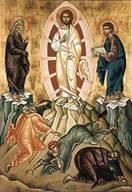Transfiguration
TRANSFIGURATION

Objectives:
- Students should understand the icon, its characters and significance.
- Students should know that the feast is celebrated on August 6.
- Why are fruits blessed on this day?
Possible Lesson Plan:
- Open with prayer.
- The icon: See how much the students already know? Christ is the central figure, clothed in white and surrounded by an aureole (elongated halo). Why? Elijah and Moses flank Him; Moses is identified because he’s carrying what? Which disciples are below Christ and why have they fallen down? (Peter, James, and John) Where are they? (Mt. Tabor)
- Scripture readings;
Gospel: Matthew 17:1-9
Epistle: II Peter 1:10-19
Old Testament: Exodus 24: 12-end, 33: 11-end, 34:4-6, I Kings 19:3-16
- Songs of the Feast:
Troparion: When Thou, O Christ our God, wast transfigured on the mountain, Thou didst reveal Thy glory to Thy disciples in proportion as they could bear it. Let Thine everlasting Light also enlighten us sinners, through the intercessions of the Theotokos; O Thou Giver of Life, glory to Thee.
Kontakion: Thou wast transfigured on the mount, and thy disciples, in so far as they were able, beheld thy glory, O Christ our God: so that, when they should see thee crucified, they would remember that thy suffering was voluntary, and could declare to all the world that thou art truly the effulgent splendor of the Father.
- Discussion questions:
What preceded the Transfiguration? (Matthew 16:13-end: Jesus asked the disciples who He was? Peter answered. Jesus then told them about His suffering to come and told them that some of them would die before seeing Him in His glory, and a few days later…) In what way was Jesus preparing his disciples for his crucifixion? Why did the disciples forget about the Transfiguration and run away like cowards? Were the disciples chosen because they were such strong and perfect men? Or were they weak and fragile and quite ordinary, just like you and me? So the Troparion recalls their weakness in “as far as they could bear it”.
Who do Moses and Elijah represent? (Law and Prophets) In the Old Testament readings, what else do we see that Moses and Elijah have in common? (They both saw God’s presence and lived to tell! Moses saw only His back on Mt. Sinai and to Elijah on Mt. Horeb He was revealed as a still, small voice.) So the Law and the Prophets of the Old Testament are witness to the revelation of God Incarnate, the New Covenant. What was another time God, the Father, spoke out of heaven in witness of His Son? (Theophany)
In Transfiguration, we see Jesus as both God and man. Is he 2 people? Which council settled this issue? (Chalcedon) These are the questions of St. Ephraim: If Jesus were not human, who lay in the manger? If He were not God, whom did the angels glorify? If Jesus were not human, whom did Simeon take in his arms? If Jesus were not God, to whom did Simeon say, “Dismiss me in peace”? If Jesus were not human, whom did John baptize? If Jesus were not God, of whom did the Father speak? If Jesus were not human, who took Peter and James and John to the mount? If Jesus were not God, who spoke with Moses and Elijah?
Why doesn’t the Holy Spirit keep the same form on Mt. Tabor (What? luminous cloud) as at the Jordan (What? dove) or at Pentecost (What? tongues of fire)? It would be easier to recognize him if He would. Jesus always appears as a man since the Incarnation. But, the Spirit is not incarnate in the dove or the fire or the cloud; “He is everywhere and fills all things”.
Can we participate in the Transfiguration? What is the point of the reading from II Peter 2 today? We can become partakers of the divine nature – not that we in some sort of union become “one with God” (nirvana of the Hindus) but by grace we can become like God. The light emanating from Jesus, what does it represent? In what ways have we not been very much like God lately? How can we become more like God?
Why do we bless fruit on the feast of the Transfiguration? It is the peak of summer in our season and the time of ripeness of fruit. Can you think of a theological meaning for this? (maybe showing that the divine can transform all created things?)
- Make a felt banner or icon as before -- see Overview. Here are a few ideas.
7. Close with prayer.